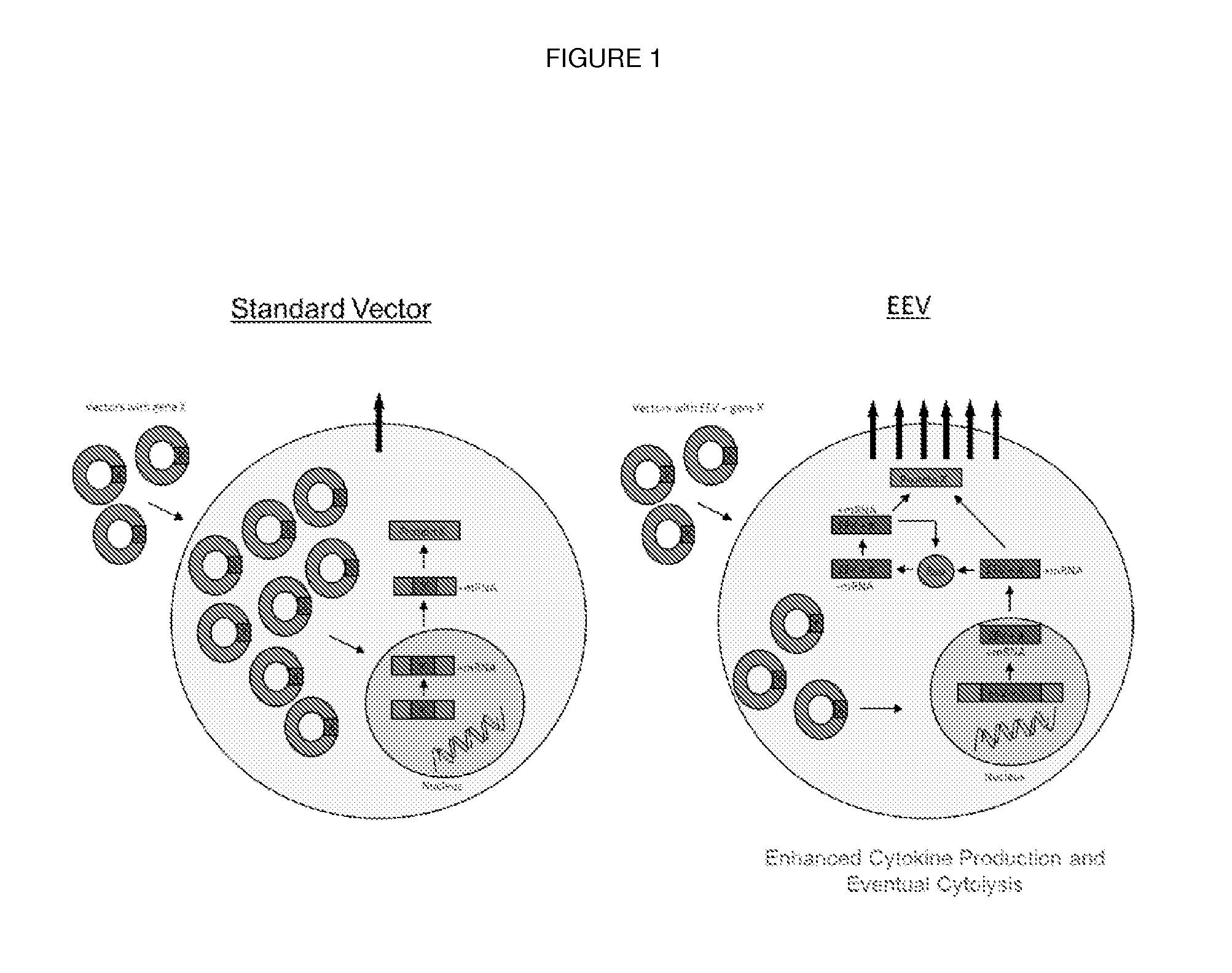Non-viral vector
a vector and non-viral technology, applied in the field of non-viral vectors, can solve the problems of low level of exogenous gene expression than is desired, adverse consequences, and general considered more hazardous in comparison to non-viral based vectors, and achieve the effect of increasing the expression level of the vector and enhancing the expression level
- Summary
- Abstract
- Description
- Claims
- Application Information
AI Technical Summary
Benefits of technology
Problems solved by technology
Method used
Image
Examples
example 1
An Enhanced Expression Vector (EEV) is Capable of Self-Replication Within the Cytoplasm
[0120]An EEV plasmid containing a luciferase transgene was incubated in a standard rabbit reticulocyte lysate cell-free system (Promega), consisting of cytoplasmic extract free of nuclear material, along with mRNA encoding for T7 RNA polymerase. As standard pCMV plasmid was used as a control and luciferase expression from each plasmid was compared. Only pEEV-luciferase expressed functional protein, as determined by the detection of luminescence, indicating the ability of pEEV but not pCMV to self-express in the presence of a cytoplasmic extract. The present inventors thus demonstrate that a pEEV vector containing an RNA replicase is able to self-replicate and express functional luciferase protein in a cytoplasmic extract free of nuclear material, whilst a conventional plasmid lacks this capacity (FIG. 2).
example 2
EEV Causes Higher Levels of Transgene Expression than a Conventional DNA Plasmids
[0121]A range of murine tissues, including a subcutaneous tumour (Oe19) and healthy tissue (muscle, liver and spleen), were subject to electroporation-mediated transfection with either 20 ug pEEV or 20 ug conventional pCMV vector, both encoding a lacZ transgene. Tissues were surgically removed after 2 days and qPCR analysis determined that, on average, a four-fold higher level of lacZ transgene expression was derived from the pEEV vector in comparison to the pCMV vector (p<0.0001) across the tissues analysed (FIG. 3A).
[0122]The level of pEEV-facilitated transgene expression in a large animal was determined by transfecting a porcine model with either pEEV-lacZ or pCMV-lacZ via electroporation. Transgene expression was determined via examination of β-Galactosidase expression, resulting from the expression of the LacZ transgene. Positive β-Galactosidase staining indicated that the plasmid DNA was successfu...
example 3
pEEV-Mediated Expression of a Non-Therapeutic Sequence Results in Cytolytic Activity.
[0123]The potential in vivo anti-tumour activity of pEEV was determined in an established tumour model. pEEV-lacZ, pEEV-backbone, pCMV-lacZ and pMG-backbone were transfected into Balb / C mice bearing CT26 tumours via subcutaneous injection with 20 μg of plasmid DNA followed by electroporation. Growth and survival rates were examined and compared to untreated CT26 tumours. The pEEV plasmid bearing a non-therapeutic lacZ transgene significantly reduced tumour volume when compared to the untreated tumour (p<0.05) (FIG. 4A). In addition, improved survival of mice transfected with pEEV was demonstrated (FIG. 4B).
[0124]To assess whether the pEEV vector induces apoptotic death in vivo, Balb / C mice bearing CT26 tumours were treated with 20 μg of pEEV, pEEV-lacZ or pCMV-lacZ via subcutaneous injection followed by electroporation. Mice were culled at 24, 48 and 72 hours post treatment and tumours were removed ...
PUM
| Property | Measurement | Unit |
|---|---|---|
| time | aaaaa | aaaaa |
| volume | aaaaa | aaaaa |
| size | aaaaa | aaaaa |
Abstract
Description
Claims
Application Information
 Login to View More
Login to View More - R&D
- Intellectual Property
- Life Sciences
- Materials
- Tech Scout
- Unparalleled Data Quality
- Higher Quality Content
- 60% Fewer Hallucinations
Browse by: Latest US Patents, China's latest patents, Technical Efficacy Thesaurus, Application Domain, Technology Topic, Popular Technical Reports.
© 2025 PatSnap. All rights reserved.Legal|Privacy policy|Modern Slavery Act Transparency Statement|Sitemap|About US| Contact US: help@patsnap.com



